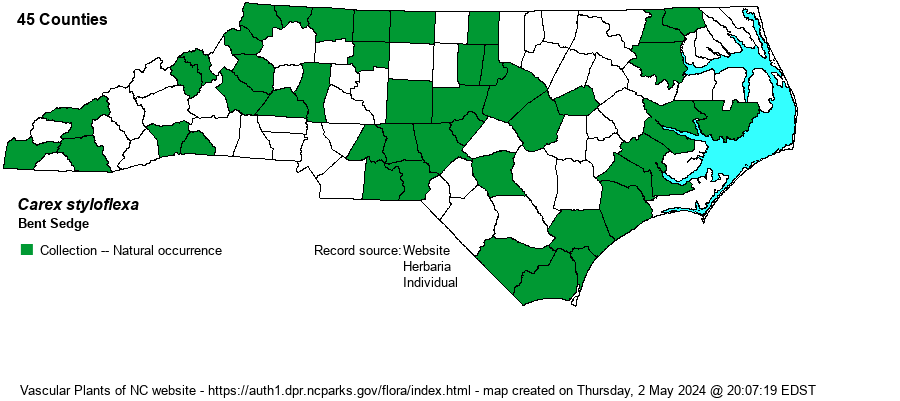| Author | Buckley | |
| Distribution | Essentially throughout the state, with possibly real gaps in the western half of the Coastal Plain and southern Piedmont. It is absent from the Sandhills proper.
CT to OH, south to FL and TX. | |
| Abundance | Uncommon to fairly common in all 3 provinces. Oddly scarce in most of the upper half of the Coastal Plain, and lacking records from the southwestern Piedmont as well. | |
| Habitat | Montane bogs, wet or swampy woods with seepage influence, springy areas, along creeks and streams. Soils are generally acidic, which is why the scarcity in the upper Coastal Plain is odd, as there are numerous wet or swampy woods with acidic/blackwater conditions in that region. |
| Phenology | Flowering and fruiting late April-June. | |
| Identification | In Bent Sedge, the lowest spikes grow at the ends of long, arching or drooping stalks (sometimes called "danglers"). C. crebriflora may also have a "dangler", but its upper spikes are densely crowded (vs. loosely in C. styloflexa). C. chapmanii differs only in possessing long horizontal rhizomes (connecting plants). | |
| Taxonomic Comments | May or may not be distinct at the species level from C. chapmanii; varietal distinction may be more appropriate.
The genus Carex is the largest in North America, and among the largest in the world. In temperate and boreal regions, Carex is often the dominant or co-dominant ground layer in many habitats. Seeds (achenes) are valuable food for birds and small mammals, while foliage is used by birds and mammals to make nests and as food by mammals. Species of Carex often look vastly different from one another -- spikes erect vs. drooping, tiny inflorescence vs. whopping, culms leafy vs. naked, perigynia beaked vs. beakless, stems densely bunched vs. single, etc. The genus has been divided into many sections (or groups), based on shared characters; some taxonomists have suggested that these be different genera, but that proves unworkable (so far). All Carex share the feature of a perigynium (an outer covering) which completely surrounds the achene (seed). This covering may fit tightly or loosely (like a small bladder), depending on which group or species. Details of perigynia shape, ornamentation, presence and size of beak, number of striations (or veins) are all important ID features. In recent years Rob Naczi and colleagues have stressed the importance of arrangement of perigynia -- whether spiral (3+ ranks) or distichous (2-ranked) -- and have named a number of new species as well as split off some older synonyms. Therefore, RAB's (1968) key, excellent for its time, can only be used in a general way today. Members of some sections of Carex are difficult to key out (notably Ovales, Laxiflorae, Griseae); this is in part due to variation among individuals of a species, or failings of the key. FNA has drawings of most species and some species may be found in two or more places within a key, to acount for variability. New species to NC, and new to science(!), continue to be found in NC. | |
| Other Common Name(s) | None | |
| State Rank | S4 | |
| Global Rank | G4G5 | |
| State Status | | |
| US Status | | |
| USACE-agcp | FACW link |
| USACE-emp | FACW link |

